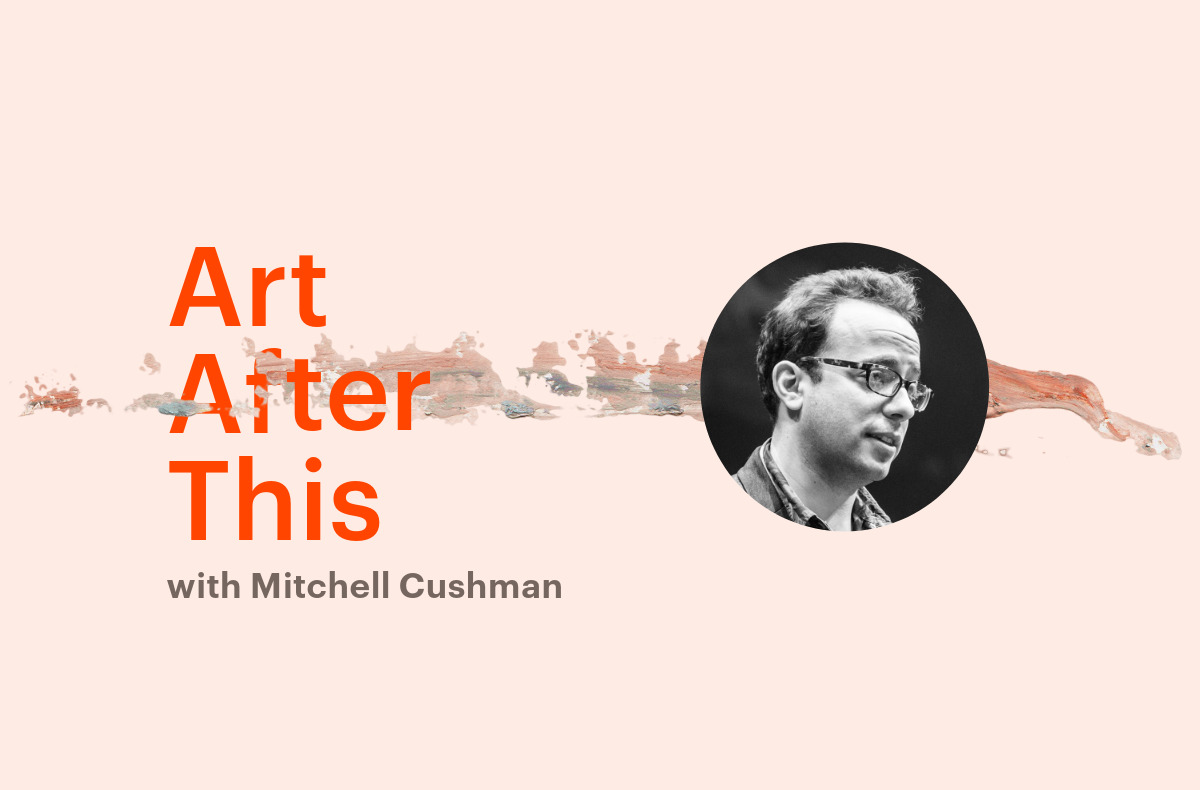By David Maggs, Metcalf Fellow on Arts and Society
Mitchell Cushman is the Artistic Director of Outside the March, an innovative theatre company known for exploring intersections between art and technology. Building on the ideas of our recent Art and Digital Technology discussion, Cushman was someone we were eager to talk to.
“What led you to this interest in art and technology?” I ask, ready for a story about video games or a first computer.
“I’m an immersive theatre artist,” he explains, “often working in site specific ways, and yeah, often working with technology but I don’t try to do that.”
“It’s just so ubiquitous?” I wonder.
“No, it’s that the question ‘what’s the right form for this content?’ is never fixed for us. We don’t start with a traditional view of theatre and make the content fit, instead we always try to let the content dictate the mode and spirit of presentation. Scrape away preconceptions of what theatre is, who it’s for, and where it happens — start with a story we want to put in front of a live audience and find the form that gets that story under the skin.”
This gets me thinking. One way to describe what we’ve been trying to do at Metcalf both during and following the pandemic, is to understand the disruptions to our sector in ways that allow us to react effectively. How do we make and resource culture for this world now? Sometimes this involves a tweak here or there, other times it asks us to reverse course on fundamental issues. Owais Lightwala and Sarah Garton Stanley offered one such reversal, imagining a shift from an artist-centred to audience-centred orientation.
Here, Cushman invites us to consider another: Typically, we take the formal dimensions of our work for granted — the stages of our theatres, the pages of our books, the frames of our paintings. But now that we are surrounded by so many different platforms beyond the traditional options, letting content lead to form in emergent, organic ways may be a path to revitalization.
“Does this always lead to technology?” I wonder.
“Often it won’t,” he shrugs, “but when it does, it gets us there in ways our content both supports and thrives within. When I think about the theatre we want to make at Outside the March, it focuses on creating active as opposed to passive experiences for audiences. Technology makes it so easy for audiences to have passive cultural experiences. So when technology meets theatre, I’m looking to create experiences that are more active than either of those typically accomplish on their own. That, to me, feels like the rumblings of a revolution.”
“Live, shared, embodied, and active?” I ask, seeking a sweet spot for live arts in a changing world.
“I find Jordan Tannahill’s Draw Me Close is inspiring here,” Cushman responds. “The audience is in VR goggles, so they are entirely within a virtual world, but there’s a live dancer interacting with them, taking their hand, tucking them into bed, grounding crucial junctures in the story with the presence of another human being as part of the experience. That’s what created the power in that piece. All the expansive, expressive power of a virtual world but that world is rooted in a very intimate, shared, embodied, active experience. That’s what excites me, when I can feel these two sides speaking to one another, teaching one another, making each other richer than the sum of their parts.”
As Cushman describes this exchange, I am reminded of a project we are developing at Metcalf in collaboration with Sheridan’s Screen Industries Research and Training Centre. “We’ve been working with this idea of transmedia,” I explain, “paralleling your instinct about finding synergies between these worlds.”
Cushman nods enthusiastically, “Outside the March often ends up there, too.”
“Dreaming in transmedia?” I ask.
“Yeah, realizing a creative idea across multiple, interacting platforms. One story that simultaneously becomes a live experience, mobile gaming, screen content, even creating physical objects, decorating our lobbies, and building out the world across just some of the different expressive platforms surrounding us right now.”
This transmedia instinct to generate multiple, integrated creative outputs from a single creative input suddenly sounds like a natural response to contemporary life. One can imagine a time when the novel was the only expressive object in the house. We didn’t have to ignore anything else to feel its power. Now we have to ignore so many dynamic, expressive platforms to immerse ourselves in just one, why not enlist these in animating different elements of a given world?
“I think of prestige television beginning 20 years ago,” Cushman muses, “making the leap into longform drama. Suddenly you could have experiences like The Sopranos or The Wire, you could analyze something deeply and develop very different relationships with the characters you’re following. That’s what I’m after with immersive theatre — expanding the canvas, looking at something from every angle, not just a thin slice of it. We are working on a piece with Todd Houseman, The Children of the Bear, trying to capture his own personal story, plus generations of Cree heritage, and then all these Dungeons & Dragons elements that colour his imagined world — doing all that simultaneously doesn’t fit within a standard established form. What I get excited about is imagining how stories can be simultaneously developed in multiple mediums and not have one version be the pale imitation of the other. Can we develop theatrical works alongside films? Can we convert theatre experiences into video games? That feels like a path to building the audiences of the future.”
“Without abandoning what we do as creators of live, shared, embodied, active experiences?” I ask.
Cushman nods.
“But you see the worry?” I continue, “that the digital means some forced exodus? Flee our homes before technocapitalism burns them down?”
“Strangely enough,” Cushman responds, “it isn’t just live needing to turn itself into the digital anymore. There’s traffic in the opposite direction too.”
“Digital trying to become live?” I ask.
“A couple months ago, I got hired to direct this live action murder mystery dinner theatre adaptation of the Knives Out films that’s currently available in Toronto. It’s called The Perfect Bite, and it’s a collaboration between Netflix and a company in Toronto called Secret City that’s primarily an escape room company. What was interesting was getting to meet the folks at Netflix whose entire job is to create live theatrical adaptations of their digital properties — bricks and mortar pavilions to allow people to disappear more deeply into the worlds of their digital content. I don’t know if there’s something utopian or dystopian about it, but I like the idea that this company that put a lot of bricks and mortar out of business is now recognizing that people don’t just want to stay inside on screens, they want to be inside the worlds that matter to them. And that leads back to us! What we do, what we’ve always done.”
“So if the digital is where people’s attention is concentrating,” I begin sorting out a strategy in my mind, “but we are starting to see them seeking live versions of what they’re experiencing over there…”
“This becomes an opportunity to create much bigger access points to what we’ve always done well,” Cushman concludes.
“I’ve often thought of this transmedia opportunity in terms of a single world with many doors,” I offer.
“The critical questions right now are, how do we do it creatively, and how do we afford it,” says Cushman. “If we want a larger creative canvas that goes beyond a single genre but we are just stretching the same resources further in order to get there, we’re going to burn people out.”
I mention the work Metcalf is doing elsewhere on the role of investment in cultural activity — where some of our activities can scale up through a mixture of grants and low-interest loans — I am curious whether Cushman thinks such a mixture might be an answer to his question about how to resource this work.
“Would I be willing to risk taking out a loan to do it?” he asks.
“Yes, but one especially built to support creative activity,” I clarify.
“Well, I’d love it if we had some way to de-risk the phase of learning how to do it first, but yes, I really believe it’s worth getting to a place where we are ready to take that risk.”
“Building transmedia projects that can explore bigger worlds with bigger audiences?” I clarify.
“Because here’s the thing,” Cushman gives a shake of his head. “Right now? We are all taking the opposite risk, by not investing in reinventing, reimagining, and revitalizing our relationship to audiences. That’s the risk we are actively participating in every day in this country. And it’s leading to slow, inevitable atrophy.”
“So, take your pick?” I wonder aloud.
“It’s a risk no matter which way we go from here. One has an exciting potential to rebuild our place in people’s worlds even though it’s new and scary and different. The other has very little potential for reward, even though it’s old and safe and familiar.”




